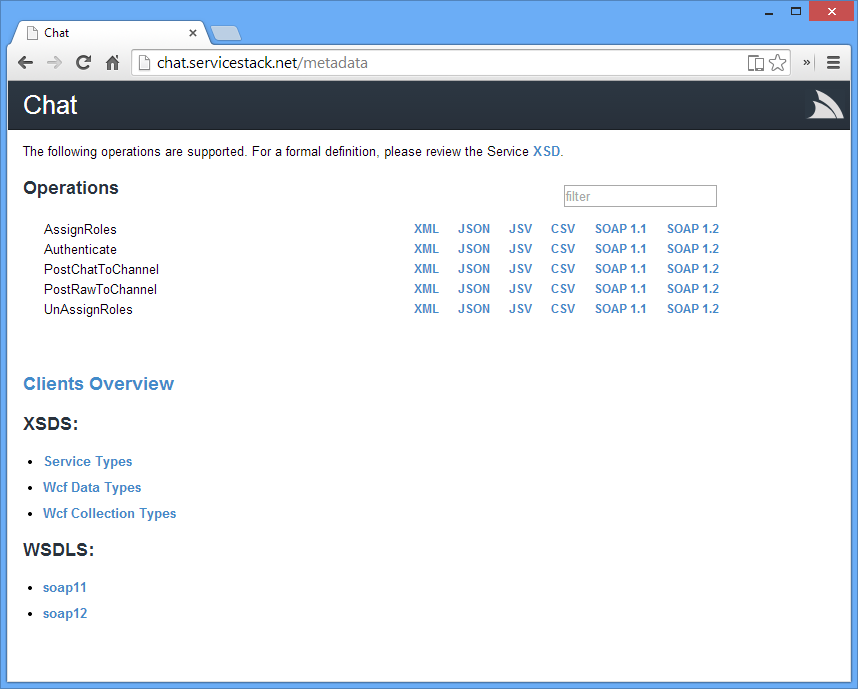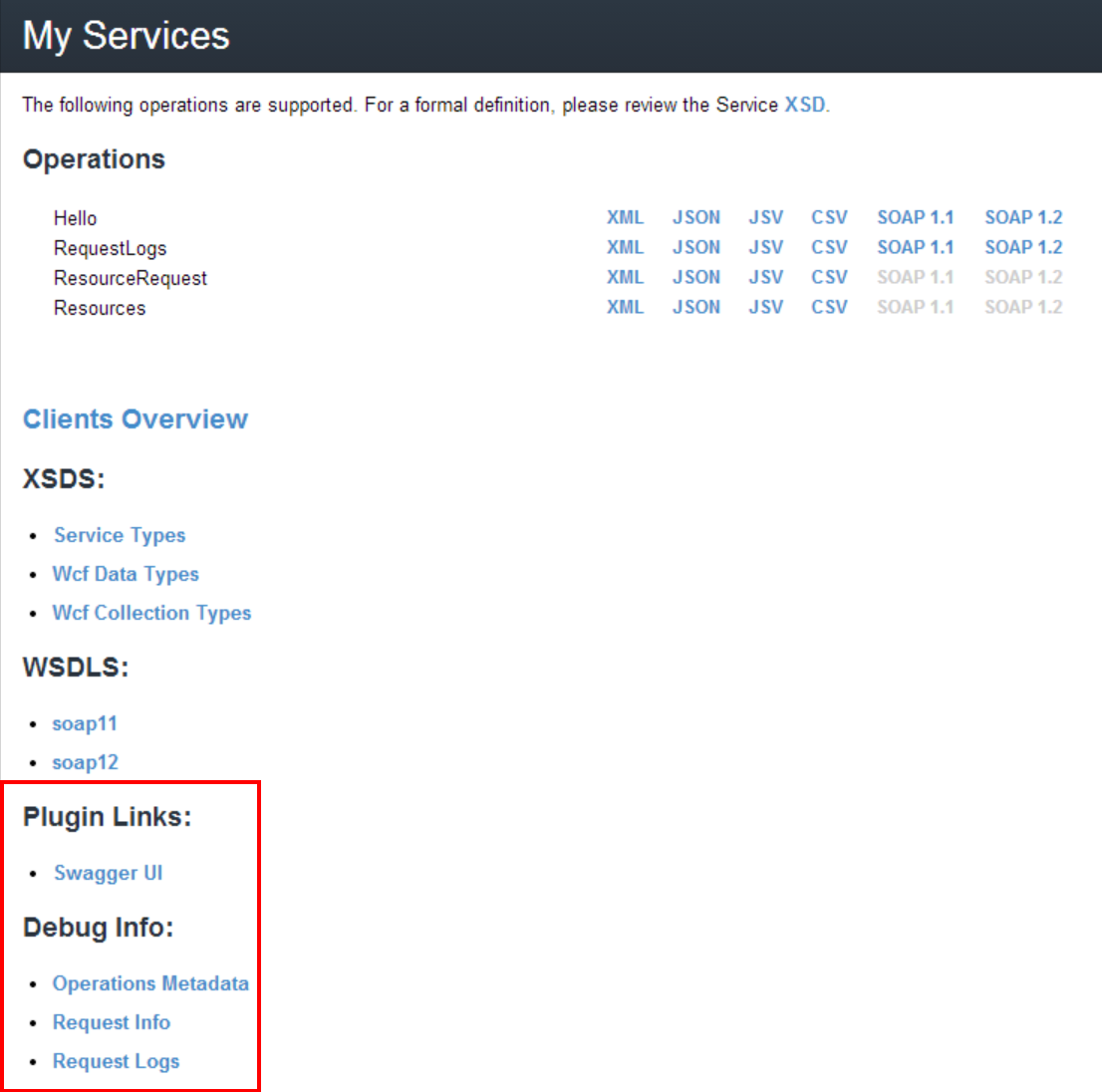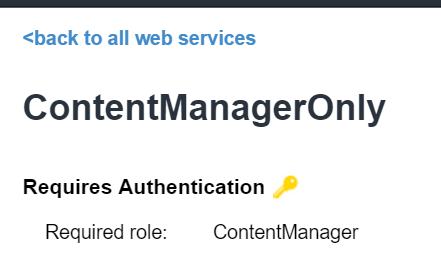Metadata page
This page has moved to docs.servicestack.net/metadata-page
ServiceStack will automatically generate a metadata page about the webservice. The metadata can be found under the URL /metadata:

The Metadata page contains:
- List of all visible web services and the endpoints they're accessible on
- Links to a detailed page of each format, with example request and responses
- Links to SOAP 1.1/1.2 WSDLs
- Links to all XSD types for all services
- Links to internally available debug metadata info
- Links to Client examples documentation
The metadata pages provide automatic generated documentation around your services, allowing consumers of your APIs to more easily introspect and provide greater visibility of your services.
You can also optionally add custom annotations and documentation on services which will automatically appear on the metadata pages. Here is an example of a fully annotated Service:
[Api("Service Description")]
[Route("/swagger/{Name}", "GET", Summary = "GET Summary", Notes="Notes")]
[Route("/swagger/{Name}", "POST", Summary ="POST Summary", Notes="Notes")]
public class MyRequestDto
{
[ApiMember(Name="Name", Description = "Name Description",
ParameterType = "path", DataType = "string", IsRequired = true)]
public string Name { get; set; }
}If now the detail page of the specific service is inspected, the description configured above will be displayed on both the Swagger UI and Metadata Detail Page:

A good place to provide better visibility of functionality in ServiceStack is with the Plugin Links and Debug Info links section to the /metadata page which add links to any Plugins with Web UI's, e.g:

The Debug Links section is only available in DebugMode (recap: set by default in Debug builds or explicitly with Config.DebugMode = true). In addition, users with the Admin role (or if Config.AdminAuthSecret is enabled) can also view the debug Plugins UI's in production.
You can add links to your own Plugins in the metadata pages with:
appHost.GetPlugin<MetadataFeature>()
.AddPluginLink("swagger-ui/", "Swagger UI");
appHost.GetPlugin<MetadataFeature>()
.AddDebugLink("?debug=requestinfo", "Request Info");AddPluginLink adds links under the Plugin Links section and should be used if your plugin is publicly visible, otherwise use AddDebugLink for plugins only available during debugging or development.
Use the IndexPageFilter and DetailPageFilter on the MetadataFeature plugin to customize the Master and detail metadata pages before they're rendered. E.g. you can reverse the order of operation names with:
var metadata = appHost.GetPlugin<MetadataFeature>();
metadata.IndexPageFilter = page => {
page.OperationNames.Sort((x,y) => y.CompareTo(x));
};The HTML templates for the metadata pages are maintained as embedded html template resources.
The VFS lets you replace built-in ServiceStack templates with your own by simply copying the metadata or HtmlFormat Template files you want to customize and placing them in your Website Directory at:
/Templates/HtmlFormat.html // The auto HtmlFormat template
/Templates/IndexOperations.html // The /metadata template
/Templates/OperationControl.html // Individual operation template
Which you can customize locally that ServiceStack will pick up and use instead.
The metadata page is a feature and can be removed by setting:
SetConfig(new HostConfig {
EnableFeatures = Feature.All.Remove(Feature.Metadata)
});This can be extended to disable as many selected features are required, e.g. to also disable SOAP support you can combine with:
SetConfig(new HostConfig {
EnableFeatures = Feature.All.Remove(
Feature.Metadata | Feature.Soap11 | Feature.Soap12)
});There are a number of different ways to match Requests with their Response DTO's for use in metadata services:
The recommended way to associate Request with their Response DTO's is to annotate the Request DTO with an IReturn<T> marker, e.g:
public class Hello : IReturn<GreetingResponse> { ... }
public class GreetingResponse { ... }This also has the primary benefit of enabling a terse and typed generic Client API as the Response type is captured in the Request DTO:
GreetingResponse = client.Get(new Hello { ... });Without the IReturn<T> marker the Response DTO would need to be specified on all call-sites, e.g:
GreetingResponse = client.Get<GreetingResponse>(new Hello { ... });An alternative way to specify the Response Type is to use the built-in naming convention:
{Request DTO Name} + Response
Where the Response DTO adds a Response suffix to the Request DTO, e.g:
public class Hello { ... }
public class HelloResponse { ... }You can also specify the Response Type by specifying it on the Services method signature, e.g:
public class MyServices : Service
{
public GreetingResponse Get(Hello request} { ... }
}Auth Info in Metadata Pages
The Metadata pages also label protected Services. On the metadata index page it displays a yellow key next to each Service requiring Authentication:

Hovering over the key will show which also permissions or roles the Service needs.
This information is also shown the metadata detail pages which will list which permissions/roles are required (if any), e.g:

- Why ServiceStack?
- Important role of DTOs
- What is a message based web service?
- Advantages of message based web services
- Why remote services should use separate DTOs
-
Getting Started
-
Designing APIs
-
Reference
-
Clients
-
Formats
-
View Engines 4. Razor & Markdown Razor
-
Hosts
-
Security
-
Advanced
- Configuration options
- Access HTTP specific features in services
- Logging
- Serialization/deserialization
- Request/response filters
- Filter attributes
- Concurrency Model
- Built-in profiling
- Form Hijacking Prevention
- Auto-Mapping
- HTTP Utils
- Dump Utils
- Virtual File System
- Config API
- Physical Project Structure
- Modularizing Services
- MVC Integration
- ServiceStack Integration
- Embedded Native Desktop Apps
- Auto Batched Requests
- Versioning
- Multitenancy
-
Caching
-
HTTP Caching 1. CacheResponse Attribute 2. Cache Aware Clients
-
Auto Query
-
AutoQuery Data 1. AutoQuery Memory 2. AutoQuery Service 3. AutoQuery DynamoDB
-
Server Events
-
Service Gateway
-
Encrypted Messaging
-
Plugins
-
Tests
-
ServiceStackVS
-
Other Languages
-
Amazon Web Services
-
Deployment
-
Install 3rd Party Products
-
Use Cases
-
Performance
-
Other Products
-
Future